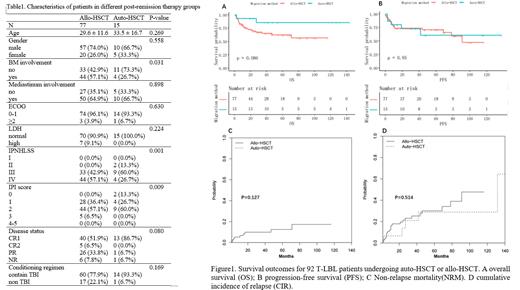Background: T-cell lymphoblastic lymphoma (T-LBL) is a rare type of non-Hodgkin's lymphoma accounting for 1%~2% of non-Hodgkin's lymphoma. T-cell lymphoblastic lymphoma is typically found in children and young adults, frequently affecting the mediastinum and bone marrow. It has a poor prognosis and develops quickly. It is anticipated that hematopoietic stem cell transplantation will significantly enhance the prognosis. We conducted a retrospective single center analysis aiming to compare the survival outcomes of autologous and allogeneic hematopoietic stem cell transplantation in patients with T-cell lymphoblastic lymphoma.
Methods: From our center's database, we track down 92 individuals who underwent T-LBL transplantation between August 2011 and June 2022, including 77 individuals who got allogeneic hematopoietic stem cell transplants and 15 patients who underwent autologous hematopoietic stem cell transplants.
Results:For the baseline characteristics of patients,there were significant differences in IPNHLSS staging, bone marrow involvement, IPI score and pre transplant status between Auto-HSCT group and Allo HSCT group.Group allo-HSCT had a higher proportion of bone marrow involvement (57.1% vs. 26.7%,p=0.031), a higher proportion of IPNHLSS staging as IV (57.1% vs. 26.7%,p=0.001) and a lower proportion of CR1 pre transplantations (51.9% vs. 86.7%,p=0.080).
Figure 1 had shown the survival between auto-HSCT group and allo-HSCT group.Among the 15 patients who received auto-HSCT, 2 patients received allogeneic transplantation after relapse, 1 patient died after 3.1 months of survival after secondary transplantation, and 1 patient still survived after secondary transplantation.The 3-year OS rate of auto-HSCT group was 87.7%, while the 3-year OS rate of allo-HSCT group was 65.0%(P=0.086).The 3-year PFS rate of auto-HSCT group was 74.0%, while the 3-year PFS rate of allo-HSCT patients was 73.3%(P=0.95). The 3-year NRM rate of auto-HSCT group was 0%, while the 3-year NRM rate of allo-HSCT group was 9.9%(P=0.127). The 3-year CIR rate of auto-HSCT group was 21.0%, while the 3-year NRM rate of allo-HSCT group was 25.3%(P=0.514).
Conclusion: Hematopoietic stem cell transplantation can significantly improve the prognosis of patients with T-cell lymphoblastic lymphoma. In our study, patients with T-cell lymphoblastic lymphomareceiving autologous hematopoietic stem cell transplantation and those receiving allogeneic hematopoietic stem cell transplantation have distinct baseline data, hence their survival rates also differ.
Disclosures
No relevant conflicts of interest to declare.


This feature is available to Subscribers Only
Sign In or Create an Account Close Modal